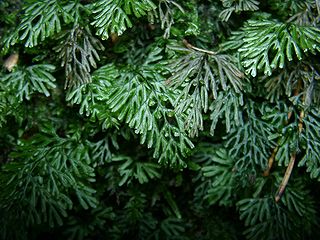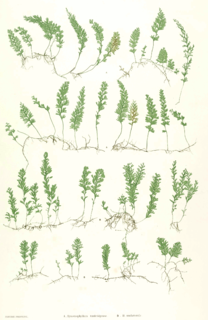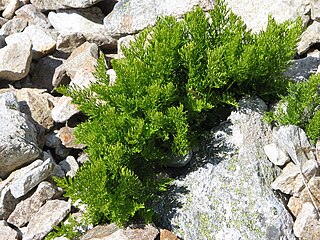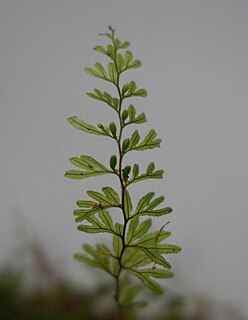
The Caha Mountains are a range of low sandstone mountains situated on the Beara peninsula in south-west County Cork, in Ireland. The highest peak is Hungry Hill, 685 m (2,247 ft) tall. Other notable peaks include Knocknagree, Sugarloaf Mountain, Eskatarriff, Knocknaveacal, Derryclancy, Nareera, Killane Mountain and Baurearagh Mountain.

The Hymenophyllaceae, the filmy ferns and bristle ferns, are a family of two to nine genera and about 650 known species of ferns, with a subcosmopolitan distribution, but generally restricted to very damp places or to locations where they are wetted by spray from waterfalls or springs. A recent fossil find shows that ferns of Hymenophyllaceae have existed since at least the Upper Triassic.

Hymenophyllum is a genus of ferns in the family Hymenophyllaceae. Its name means "membranous leaf", referring to the very thin translucent tissue of the fronds, which gives rise to the common name filmy fern for this and other thin-leaved ferns. The leaves are generally only one cell thick and lack stomata, making them vulnerable to desiccation. Consequently, they are found only in very humid areas, such as in moist forests and among sheltered rocks. They are small and easy to overlook.

Hymenophyllum nephrophyllum, the kidney fern, is a filmy fern species native to New Zealand. It commonly grows on the forest floor of open native bush. Individual kidney-shaped fronds stand about 5–10 cm tall. In hot weather they shrivel up to conserve moisture, but open up again when the wet returns. This species has very thin fronds which are only four to six cells in thickness. In the Māori language they are also called raurenga.

Selaginella selaginoides is a non-flowering plant of the spikemoss genus Selaginella with a wide distribution around the Northern Hemisphere. It resembles a moss in appearance but is a vascular plant belonging to the division Lycopodiophyta. It has a number of common names including lesser clubmoss, club spikemoss, northern spikemoss, low spikemoss and prickly mountain-moss. This plant has one close relative, Selaginella deflexa, native to Hawaii. These two plants form a small clade that is sister to all other Selaginella species.

Hymenophyllum moorei is a rare species of filmy fern in the family Hymenophyllaceae. It is endemic to the high cloud forest at Mount Gower and Mount Lidgbird at Lord Howe Island. A small epiphytic fern found usually on tree trunks and fallen logs.

Hymenophyllum cupressiforme is a southern hemisphere species of filmy fern. Found in moist sheltered areas, in or near rainforests. Occasionally found in drier protected areas. Leaves one cell thick. A small epiphytic fern found on tree trunks, rocks and fallen logs.

Cryptogramma crispa, the parsley fern, is an Arctic–alpine species of fern. It produces separate sterile and fertile fronds, up to 30 cm (12 in) tall, and is a pioneer species on acidic screes.

Hymenophyllum australe, commonly known as austral filmy fern, is a relatively large rupestral and epiphytic fern, indigenous to eastern Australia and New Zealand. It belongs to the unique Hymenophyllum genus, which are characterised by their thin membranous fronds that are seldom more than one cell thick, with the exception of regions over and around veins. Hymenophyllum australe is distinctive in that the fronds are typically thicker than other Hymenophyllum species, often being up to 2-3 cells thick.

Hymenophyllum flabellatum, the shiny filmy-fern, is a species of fern in the family Hymenophyllaceae. This delicate fern is commonly epiphytic and is between 5 and 25 cm in length. It is distinct, with its thin, one-celled thick, membranous leaves. It is from the family Hymenophyllaceae and is dispersed world wide. The species is dispersed highly throughout Tasmanian rainforests and in the south east of mainland Australia, with small pockets of the population seen in northern Queensland.
Michael Charles Faraday Proctor PhD was an English botanist and plant ecologist, lecturer, scientific author based at the University of Exeter. He retired from his post as Reader in Plant Ecology at Exeter University in 1994.
William M. Wilson (1799–1871) was an English botanist, known for his focus on bryology.

Hymenophyllum tunbrigense, the Tunbridge filmy fern or Tunbridge filmy-fern, is a small, fragile perennial leptosporangiate fern which forms large dense colonies of overlapping leaves from creeping rhizomes. The common name derives from the leaves which are very thin, only a single cell thick, and translucent, giving the appearance of a wet film. The evergreen fronds are bipinnatifid, deeply and irregularly dissected, about 3 to 6 cm long, 2 cm across with dark winged stipes. In contrast to the similar H. wilsonii the fronds are more divided, flattened, appressed to the substrate and tend to have a bluish tint.
Tasmania is home to 'Australia’s largest cool temperate rainforests... Most of Tasmania’s rainforests occur in the North-West and throughout the North East highlands. Cool temperate rainforests typically have a heavy rainfall, cool climate, favor high altitudes and have a limited availability of light.

Dryopteris aemula, the hay-scented buckler-fern or hay-scented fern, is a species of perennial leptosporangiate fern.
Mary Agnes Stump Taylor (1885-) was an American bryologist noted for collecting and identifying many species of bryophytes across North America. Her collection of around 8,000 plants was so extensive that it has been used to identify the range of plants several decades after their original collection. The standard author abbreviation M.S.Taylor is used to indicate this person as the author when citing a botanical name.

Hymenophyllum rarum, the narrow filmy-fern, is a species of fern from the family Hymenophyllaceae. This thin-leaved fern is commonly found in New Zealand and Tasmania, growing in patches on rocks and is epiphytic on trees and tree ferns, growing in moist gullies or rainforests. A rather drought tolerant species often found at exposed sites ranging from coastal to montane areas. Forming extensive, interwoven and creeping patches with its thin long (creeping) rhizomes sparsely covered in red-brown hairs, easily recognised by its membranous grey-green fronds, the smooth margins of the pinnae, ultimate segments and indusia; and by the sunken sori in the uppermost segments of the uppermost pinnae. The species can be found throughout Tasmanian rainforests as well as occurring in New South Wales, Victoria and New Zealand on the North and South Islands as well as, Stewart, Chatham and Auckland Islands.

Hymenophyllum peltatum, is a species of filmy fern widely distributed across Australia, New Zealand, South Africa, South America. Predominantly a rainforest species with delicate foliage arrangements, also known as the 'alpine filmy-fern'. Members of the Hymenophyllaceae family display almost translucent fronds, bearing thickness of just a single cell.

Hymenophyllum bivalve is a species of filmy fern. Found in moist sheltered areas, in or near mountain rainforests in Australia and New Zealand. The habitat is on tree trunks, rocks and fallen logs.


















